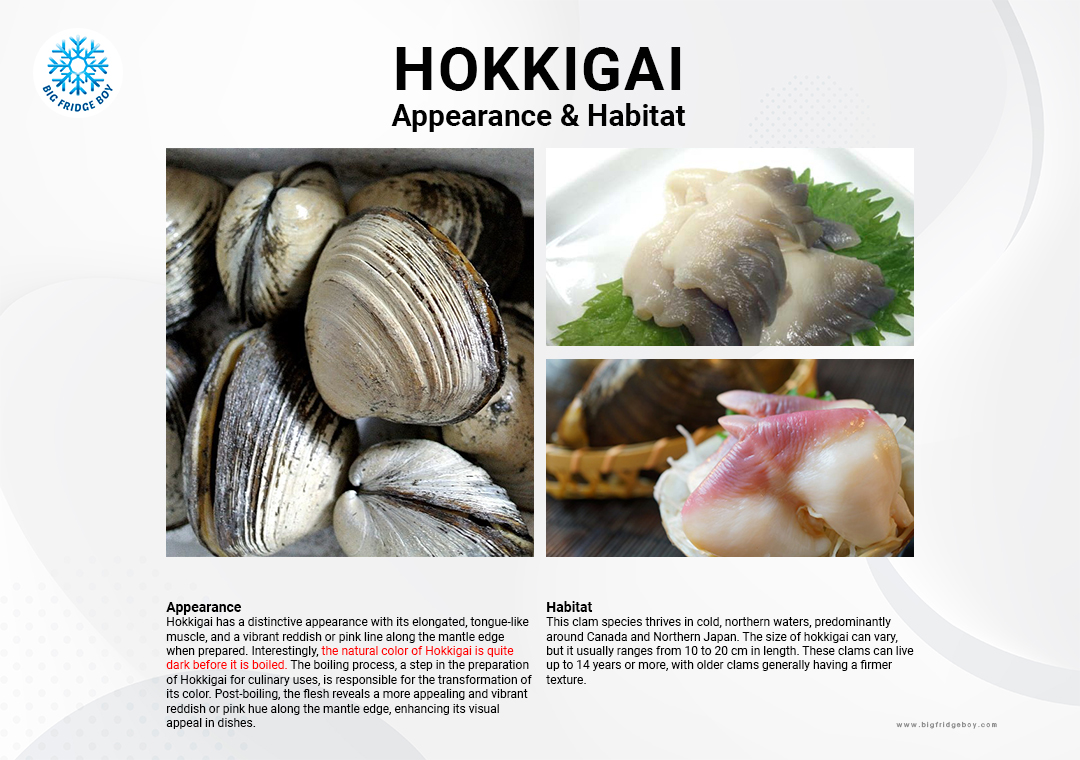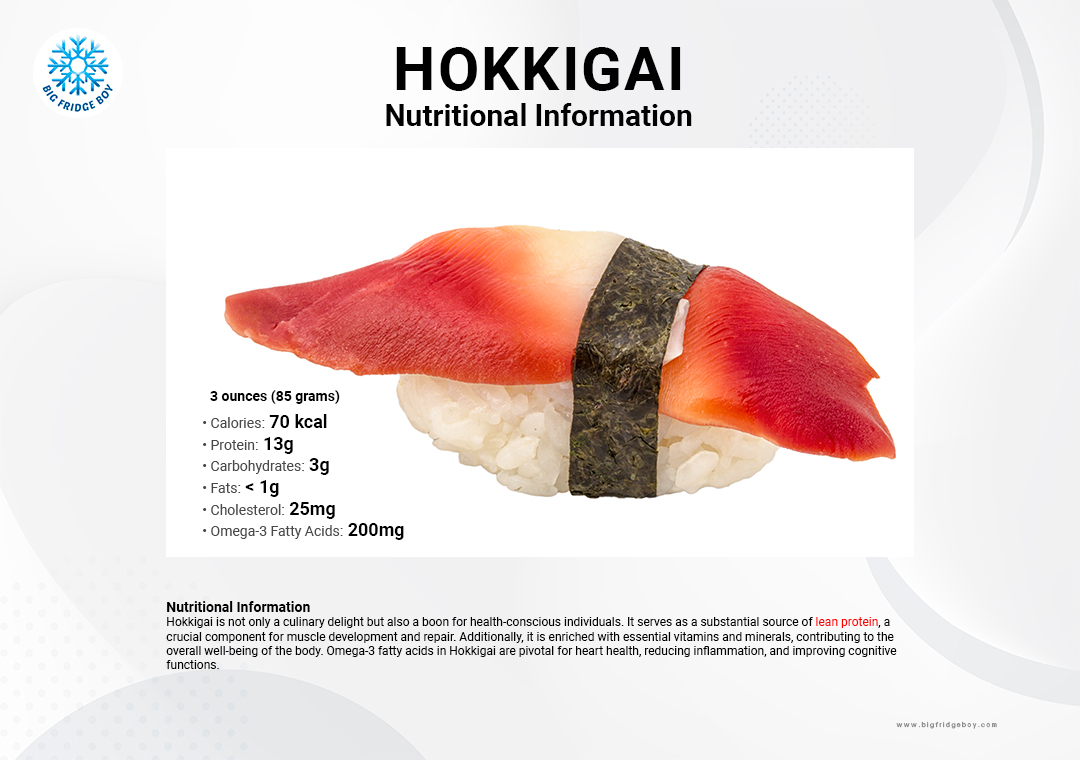Hokkigai (Surf Clam): A Culinary Gem from the Sea
Last updated: 4 Oct 2023 | 7174 Views |

Hokkigai (surf clam), a delightful seafood delicacy hailing from the cold waters of the northern hemisphere, is revered for its unique attributes in taste, texture, and appearance. This exotic marine produce holds an esteemed place in Japanese cuisine, significantly enriching the culinary heritage with its presence in diverse dishes like sushi and sashimi.
- Scientific Name: Spisula sachalinensis
- Japanese Name: ホッキ貝 or Hokkigai
- Species: It belongs to the family Mactridae and is a species of surf clam.
- Other Names: It is also known as the Arctic surf clam, with variants found in the colder northern waters around Canada and Northern Japan.

Appearance and Habitat
- Appearance: Hokkigai has a distinctive appearance with its elongated, tongue-like muscle, and a vibrant reddish or pink line along the mantle edge when prepared. Interestingly, the natural color of Hokkigai is quite dark before it is boiled. The boiling process, a step in the preparation of Hokkigai for culinary uses, is responsible for the transformation of its color. Post-boiling, the flesh reveals a more appealing and vibrant reddish or pink hue along the mantle edge, enhancing its visual appeal in dishes.
- Habitat: This clam species thrives in cold, northern waters, predominantly around Canada and Northern Japan.
- Size: The size of hokkigai can vary, but it usually ranges from 10 to 20 cm in length.
- Age: These clams can live up to 14 years or more, with older clams generally having a firmer texture.
Flavor and Texture
The age of Hokkigai, or surf clam, does play a significant role in determining its taste and texture, offering a diverse sensory experience.
Texture
- Younger Hokkigai: They tend to have a more tender, delicate, and succulent texture, making them preferable for dishes where a softer consistency is desired, such as in some sashimi or lightly cooked preparations.
- Older Hokkigai: They usually possess a firmer, denser, and more chewy texture. This characteristic can be desirable in dishes where a robust texture is valued, possibly in stir-fries, grills, or other high-heat cooking methods.
Taste
- Younger Hokkigai: They often have a milder, subtler flavor, reflecting their shorter time in the marine environment absorbing the ocean’s essence.
- Older Hokkigai: They might present a more concentrated, pronounced flavor profile, having spent more time in the sea interacting with their surroundings.
Inedible Parts: The edible part of hokkigai is the muscular foot or "tongue." The inedible parts, such as the gut, are removed during preparation.

Nutritional Information
Hokkigai is not only a culinary delight but also a boon for health-conscious individuals. It serves as a substantial source of lean protein, a crucial component for muscle development and repair. Additionally, it is enriched with essential vitamins and minerals, contributing to the overall well-being of the body. Omega-3 fatty acids in Hokkigai are pivotal for heart health, reducing inflammation, and improving cognitive functions.
Hokkigai, like many other shellfish, is generally low in calories and fats and is a good source of protein. While exact nutritional values may vary slightly based on size and preparation, a general nutritional breakdown per 3 ounces (85 grams) of raw surf clam might look like this:
- Calories: 70 kcal
- Protein: 13g
- Carbohydrates: 3g
- Fats: < 1g
- Cholesterol: 25mg
- Omega-3 Fatty Acids: 200mg
Culinary Uses
Hokkigai is a versatile ingredient that shines in various culinary applications, notably in sushi and sashimi, where its sweet flavor and firm texture are highly valued. Apart from these, it can also be used in soups, salads, and other seafood dishes, providing a unique flavor profile.
Best Season to Eat
The best season to enjoy hokkigai is during the colder months, typically from late fall to early spring, when the clams are harvested, and their flavor is at its peak.
How to Keep Fresh and Frozen
To maintain the freshness of hokkigai, it should be kept in a refrigerator at a temperature just above freezing typically around 32°F to 34°F (0°C to 1°C), and consumed within a couple of days. For longer storage, freezing is recommended at 0°F (-18°C) or lower. Before freezing, it’s advisable to clean the clams thoroughly and place them in airtight bags to preserve their flavor and texture. When ready to use, thawing them slowly in the refrigerator is recommended to maintain the integrity of their texture and flavor.






